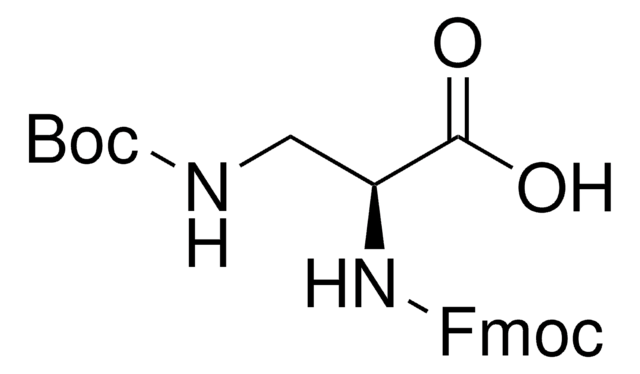810332P
Avanti
18:1 PE CF
Avanti Polar Lipids 810332P, powder
Synonym(s):
1,2-dioleoyl-sn-glycero-3-phosphoethanolamine-N-(carboxyfluorescein) (ammonium salt)
Sign Into View Organizational & Contract Pricing
All Photos(2)
About This Item
Empirical Formula (Hill Notation):
C62H94N3O14P
CAS Number:
Molecular Weight:
1136.40
UNSPSC Code:
12352211
NACRES:
NA.25
Recommended Products
Assay
>99% (TLC)
form
powder
packaging
pkg of 1 × 1 mg (810332P-1mg)
pkg of 5 × 1 mg (810332P-5mg)
pkg of 5 × 2 mg (810332P-10mg)
manufacturer/tradename
Avanti Polar Lipids 810332P
shipped in
dry ice
storage temp.
−20°C
General description
Phosphatidylethanolamine (PE) is a glycerophospholipid. 1,2-dioleyl-sn-glycero-3-phosphoethanolamine-N-carboxyfluorescein (CFPE) is a two-chain lipid. It is a fluorescent phospholipid, which carries a fluorophore in its headgroups.
Application
18:1 PE CF may be used:
- to prepare fluorescent-labeled large unilamellar vesicles (LUV)
- in small unilamellar lipid vesicles (SUVs) to increase fluorescence
- to prepare fluorescent liposomes
- to fabricate fluorescent nanomicelles
Biochem/physiol Actions
Phosphatidylethanolamine (PE) plays a vital role in the structure and function of eukaryotic membranes.
Packaging
5 mL Amber Glass Screw Cap Vial (810332P-10mg)
5 mL Amber Glass Screw Cap Vial (810332P-1mg)
5 mL Amber Glass Screw Cap Vial (810332P-5mg)
Legal Information
Avanti Research is a trademark of Avanti Polar Lipids, LLC
also commonly purchased with this product
Product No.
Description
Pricing
Storage Class Code
11 - Combustible Solids
Certificates of Analysis (COA)
Search for Certificates of Analysis (COA) by entering the products Lot/Batch Number. Lot and Batch Numbers can be found on a product’s label following the words ‘Lot’ or ‘Batch’.
Already Own This Product?
Find documentation for the products that you have recently purchased in the Document Library.
Danielle Hirsch-Lerner et al.
Biochimica et biophysica acta, 1714(2), 71-84 (2005-07-30)
Lipoplexes, which are complexes between cationic liposomes (L+) and nucleic acids, are commonly used as a nucleic acid delivery system in vitro and in vivo. This study aimed to better characterize cationic liposome and lipoplex electrostatics, which seems to play
Yueheng Zhang et al.
Langmuir : the ACS journal of surfaces and colloids, 35(47), 15335-15343 (2019-11-07)
Peptoids are highly biocompatible pseudopeptidic polyglycines with designable substituents on the nitrogen atoms. The therapeutic and drug-carrying potential of these materials requires a fundamental understanding of their interactions with lipid bilayers. In this work, we use amphiphilic polypeptoids with up
Yashi Wang et al.
Journal of controlled release : official journal of the Controlled Release Society, 321, 71-83 (2020-02-09)
Oxidative-stress defense system stands for the vulnerability of tumor cells because of the stronger oxidative stress existing in tumor sites. TRPA-1 has been found to be overexpressed in various tumors, related to the tumor proliferation and metastasis, and promote reactive
Rachel R Kroe et al.
Analytical biochemistry, 390(1), 1-13 (2008-12-24)
Analytical ultracentrifugation is a widely used method for characterizing the solution behavior of macromolecules. However, the two commonly used detectors, absorbance and interference, impose some fundamental restrictions on the concentrations and complexity of the solutions that can be analyzed. The
Hong Ding et al.
Nanotechnology, 25(5), 055101-055101 (2014-01-11)
The blood-brain barrier (BBB) is considered as the primary impediment barrier for most drugs. Delivering therapeutic agents to the brain is still a big challenge to date. In our study, a dual mechanism, receptor mediation combined with external non-invasive magnetic
Our team of scientists has experience in all areas of research including Life Science, Material Science, Chemical Synthesis, Chromatography, Analytical and many others.
Contact Technical Service








